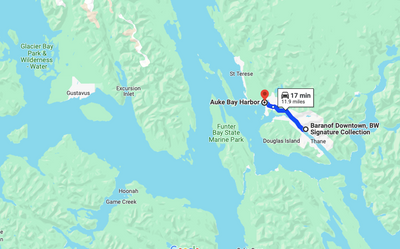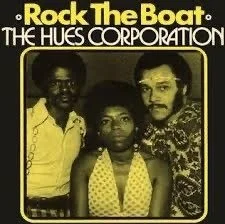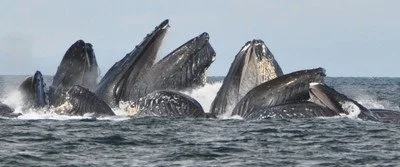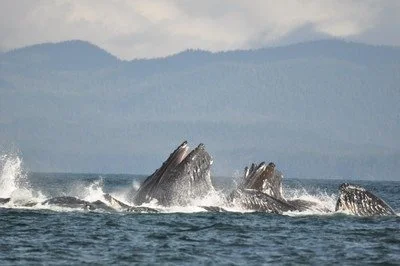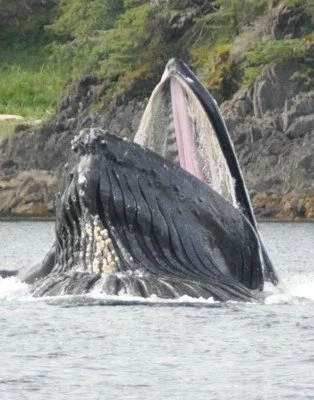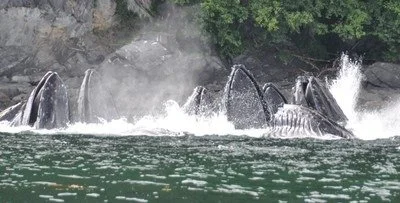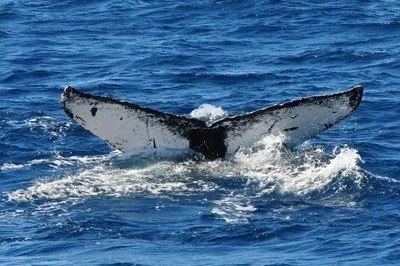Chapter 11: Whale Trust Photo Safari
First Day on the Water. Wow.
I came to see Humpback Whales (Megaptera novaeangliae), hopefully bubble-net feeding at least once, Killer Whales (Orcinus orca), Stellar's Sea Lions (Eumetopias jubata), Bald Eagles (Haliaeetus leucocephalus) and Brown Bears (Ursus arctos). First on the agenda, of course, is the majestic humpback.
My alarm is set for 5:30am but I wake an hour before. Not only is it "late" by my body clock standard--8:30am in Kansas City--but I am anxious to get moving, to commence this new adventure. I chat with B4 on the phone and jot these few notes.
6:30am--meet for pickup at the lobby of the hotel; drive 20 minutes to Auke Bay.
7:00am--arrive at Auke Bay Marina where our boat, The Riptide, awaits us. Eat breakfast at the Hot Bite Restaurant. Jeff makes us salmon patties over fried egg all resting on crispy french fries. We are anxious to make our way down the ramp to our vessel.
8:00am--First Mate Andrew casts off our lines and Captain Josh pilots us away from the pier as we head out into Auke Bay to commence our search for humpbacks.
In these waters, they will be easy to find. Whales overwhelm other animals in size:
Blue Whale - 98 feet.
Fin Whale - 90 feet.
Sperm Whale - 67 feet.
Right Whale - 60 feet.
Bowhead Whale - 59 feet.
Humpback Whale - 52 feet.
Sei Whale - 52 feet.
Gray Whale - 49 feet.
I have an ear worm from The Hues Corporation's big song of 1973:
So I'd like to know where, you got the notion
Said I'd like to know where, you got the notion
To rock the boat (don't rock the boat, baby)
Rock the boat (don't tip the boat over)
Rock the boat (don't rock the boat, baby)
Rock the boat
With that melody in my brain during this long day aboard the 34-foot aluminum "Riptide," and recent YouTube footage of a humpback crashing down on top of a fishing boat, (see it here: https://www.youtube.com/results?search_query=humpback+whale+jump+on+boat), I offer up this chance to be aboard with us.
Not quite two hours out of Auke Bay, after moving from flat water to light chop, to and through fog banks with clouds slowly breaking up overhead, we encounter a few Dalls Porpoise who play off the bow of the Riptide. We slow to watch them play with us and grab a quick iPhone video. We have seen a few whale tails but we are after more intimate experiences than they could offer so we mostly ignore them. Had we been in Cabo, we would stopped and thought that to be a high point. Not today.
Around ten we spot a humpback just off the Icy Strait Pointe cruise docks. It is lollygagging along the shore, casually feeding, offering up spouts and dorsal fin shots. After a few minutes, we leave it to its meals.
A half hour later, a ‘raft’ of otters appears. Skittish, they aren’t fond of us as voyeurs and they depart. So do we.
Soon after: jackpot.
The thing I came to see I saw not once, not five times but over and over again. Bubble net feeding. Working as an organized group, what we think was 16-18 individual humpbacks averaging 40 tons in weight dove, organized themselves (possibly through song communication which we could hear) and then rocketed to the surface through a school of herring. They each scoop up a mouthful of maybe 20 herring per whale. Again and again and again.
In Cabo, the thrill is to see a tail. Here, we see dozens and dozens. In Cabo, we have seen the occasional breech—when a humpback rockets itself to the surface and breaks it, going partially airborne, lifting 80 to 90 per cent of its entire body out of the water, falling back with a giant splash of sea water. We see that here as well. A lot. We all try for the perfect photograph or video of the breeches but those are tough to get. You have no idea of when or where a breech will occur. But, when all of us pivot at once, raising cameras in unison, trying to get the power on and the focus right, it is because still another spectacular display has occurred. Tomorrow, after we have had a chance to assess what we actually recorded, bragging rights will be claimed, images shared and praise delivered.
The eleven people on board, Maria, Grayson, Nancy, Peter, Ann, Thuha, Josh, Andrew, Mark, Ralph and me? We are giddy. I shot photographs with my long lens, some with my shorter lens, some video with my iPhone and then I engaged in the luxury of just watching with no camera. Once, we were all distracted when a clueless twosome split the waters between the whales and Riptide; I'm not sure they even knew they did it.
I did not know, but learned, that humpbacks trumpet with a sound that reminds me of what you hear if you slide a piece of heavy furniture across a floor. Or, perhaps, a poorly executed french horn blow. I am reminded of elephants but it is not the same. Whatever it is, it is magical to both see and hear these amazing creatures working as a team. They are here to fatten themselves up and this group seems to be doing an amazing job of that.
At two, we break for lunch cruising alongside the whales who are parallel to us along the shore perhaps 80 yards away. Familiarity breeds contempt says the saying. Here, familiarity breeds acceptance, peace and a mutual acceptance. It was a fine floorshow—the best mealtime entertainment one could ask for.
At 3:45, between repeated bubble net feeding opportunities, Josh spotted a coastal brown bear on the shore of False Bay. The bear meandered a bit and then disappeared into the forest. Another first for me—a bear in the wild.
After still more bubble net events, at a bit after 4:00, it is time to head back to Auke Bay.
Two specific whales stand out today. First is “Ruffles.” Their dorsal ruffles, it is believed, were caused by brushing against the prop of a fast moving prop. Second is “Fingers.” Their severely scarred left tail is believed to be another prop injury. Both whales seems to be none the worse for wear.
Humpbacks migrate for 3,000 miles or more every year. From Juneau, some head to Hawaii or Asia and some make a port call on our home in Cabo San Lucas from November through April. The Baja group mate, give birth and begin raising their calves around Cabo and then, avoiding the dangerous killer whales along the way, escort their baby back here to Alaska.
Their success rate must be a good one. Eight years ago the National Oceanic and Atmospheric Administration (NOAA) Fisheries delisted these Juneau humpbacks from the endangered species list after having been listed there since 1970. Commercial whaling was rampant then. The International Whaling Commission issued a “whaling moratorium” in 1982 which remains in effect to this day.
These whales remain protected under the 1972 Marine Mammal Protection Act. What happens if you kill a whale? Quick research indicates that your vessel and its cargo may be forfeited after a fine of up to $25,000 is imposed on it along with a fine of up to $34,457 on you while you spend up to 1 year in prison.
For us, it is illegal to approach humpback whales within 100 yards. There is no rule about the humpbacks approaching us.
There exists a document called the Southeast Alaska Humpback Whale Catalog where observed individual whales are both numbered and named. Humpbacks boast a lifespan of 80 to 90 years. Just under 2,000 different humpbacks are listed in the catalog, having been identified since 1979. The underside of whale flukes (tails) carry a unique black and white pattern which is akin to a fingerprint for individual identification.
Here are three fluke photographs I took years ago while in Cabo. As we motor back to the harbor at Auke Bay, I wonder if I ran across any of these on this trip.
